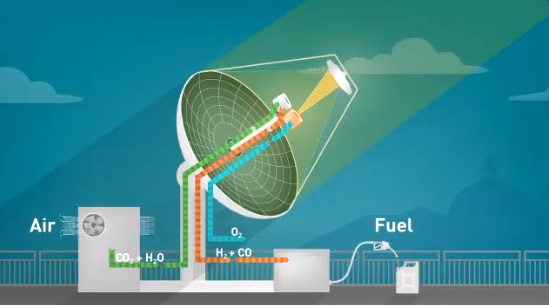ETH Zurich (the Swiss Federal Institute of Technology), is recycling and reusing CO2 to make jet fuel as part of a carbon-neutral process. This is not a new idea, with others’ approaches to this detailed in earlier blog entries here, here, and here. Centered on a solar collector/reactor on the roof of ETH’s Machine Laboratory building in Zurich, researchers have “developed a novel technology that produces liquid hydrocarbon fuels exclusively from sunlight and air and have demonstrated the entire thermochemical process chain under real field conditions.” Extracting CO2 and water directly from ambient air through an adsorption/desorpton process, the system feeds these free materials into a solar reactor that is at the focus of the parabolic reflector that heats them to 1,500° Celsius. A cerium oxide structure in the reactor enables a redox (oxidation-reduction reaction)* cycle, with syngas an end product. This gas can be processed into a commercially-viable hydrocarbon fuel through conventional methanol or Fischer-Tropsch synthesis, according to GreenCarCongress. …
Rust and Sunshine Do Mix
Chemists at Boston College in Chestnut Hill, Massachusetts, “Have achieved a series of breakthroughs in their efforts to develop an economical means of harnessing artificial photosynthesis by narrowing the voltage gap between the two crucial processes of oxidation and reduction, according to their paper, “Hematite-Based Water Splitting with Low Turn-on Voltage,” published this week in the journal Angewandte Chemie.” With your editor wishing he’d paid more attention in high-school chemistry, a quick search came up with simple definitions of oxidation and reduction. Oxidation is gain of oxygen. Reduction is loss of oxygen. When reduction and oxidation take place simultaneously, this is known as a redox reaction. These types of reactions take place in leaves producing plant energy from sunlight, and researchers are closing in on duplicating the reactions at a level which will make artificial photosynthesis an inexpensive, practical way to collect and store energy. So far, they’ve managed to produce 80 percent of the necessary voltage levels from their unique photoanodes and photocathodes. …

